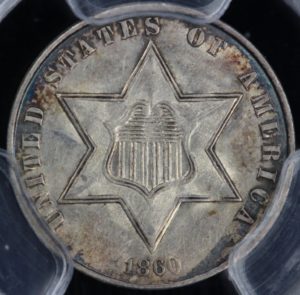Three Cent Silvers (1851-1873)
A couple of circumstances led to the creation of Three Cent Silver in 1851.
First, gold was discovered in Sutter’s Mill in California in 1848. The increased mining of gold affected US coinage as its value depressed compared to silver. As a result, silver coins were hoarded and melted since they were worth more in that state. That, and the fact that fewer people were taking  silver to the Mint for transformation into coinage limited the production of silver coins.
silver to the Mint for transformation into coinage limited the production of silver coins.
By the time 1851 arrived, there was a scarcity in silver coins causing trouble for merchants and their customers when it came to giving change.
At this point, federal officials were also thinking about reducing the postal rate from five to three cents. A Senator from New York by the name of Daniel Stevens Dickinson then proposed a three-cent coin for the purpose of buying stamps.
On March 3, 1851, the proposal for a three cent piece was approved.
History of Three Cent Silvers
The three cent silver was struck by the US Mint from 1851 to 1872.
Conventional silver coins were made of .900 silver, but Congress allowed the creation of a .750 silver coin in 1851. As a result, the three cent piece in silver became the first US coin containing metal that is valued less than its face value.
The trime, as it was also called, circulated well but was less used when the issue of hoarding and melting ceased to be a problem. The coin was abolished via the Coinage Act of 1873.
Design of Three Cent Silvers
Chief Engraver James B. Longacre was in charge of the three-cent piece’s design. He found it difficult to do since the coin was small, but nonetheless came up with a design.
Three varieties were produced throughout its run:
- Type 1 Three-Cent Silver. The obverse featured a nationalistic shield that was superimposed on a six-pointed star. Circling the design were the words UNITED STATES OF AMERICA. On the coin’s reverse were the coins value, indicated by the Roman numeral III, which in turn is within a beaded “C.” The usual thirteen stars encircled the border. This design was produced from 1851 to 1853.
- Type 2 Three-Cent Silver. Congress passed legislation in 1854 for the reduction of weight of the half dollar, the quarter, dime, and half dime. This was so silver coins wouldn’t be hoarded. Congress also authorized an increase in fineness up to 90% for silver coins. Coins that fit this bill appeared in 1854, with Longacre making modifications to differentiate it from previous versions. The star in the obverse of this version had two extra outer rims while the reverse featured lots of arrows and and olive branch. This coin was made from 1854 to 1858.
- Type 3 Three-Cent Silver. The modifications for Type 2 Three-Cent Coins caused striking problems. As such, Longacre made changes once more and that design was used until the coin ceased being produced in 1873. For this version, the number of outlines around the star were reduced to two. Longacre also used narrower type that was spaced farther apart, plus the numeral’s size was reduced as well.
Collecting Three Cent Silvers
Type 1 Three Cent Silvers were produced in large quantities because of the need. The Philadelphia Mint made most of the coins, with the New Orleans mint chipping in and as such, their version is pretty scarce.
Less than five million Type 2 Three Cent Silvers were struck, all of them at the Philadelphia mint. In its four-year run, the 1855 coin had the lowest mintage.
All Type 3 Three Cent Silvers were made at the Philadelphia Mint. Since no three-cent pieces circulated after 1862, the business strikes produced between 1863 and 1873 are considered rarities.
